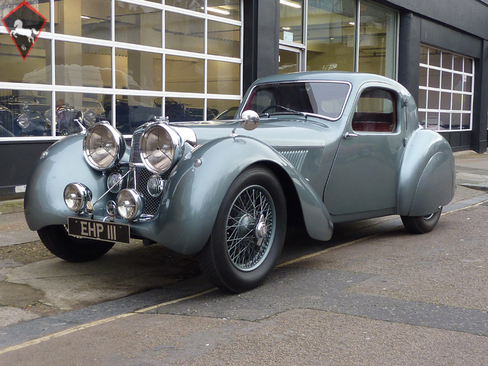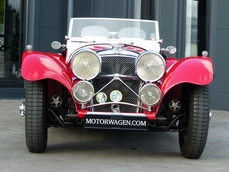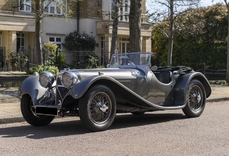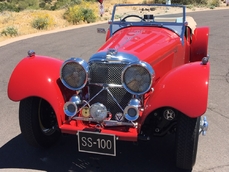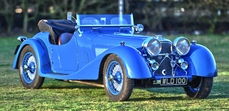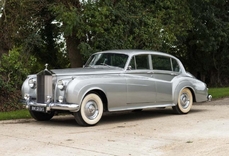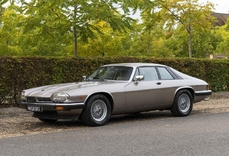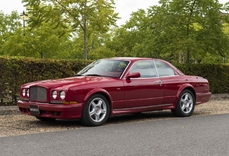SS 100 1938
Allgemeine Beschreibung :
Breathtakingly beautiful and unique. Rarer than a Bugatti Atlantique and arguably just as pretty. Still finished in its original Gunmetal Grey with Red leather colour scheme, This is definitely one of the most important Jaguars ever built and would be the centre piece of any serious World Class Jaguar collection.
1938 SS100 Jaguar Grey Lady Fixed Head Coupe This stunning fixed-head coupe was one of the most closely guarded Show Secrets of 1938. Unveiled to popular acclaim on the SS Jaguar stand at Earls Court, it gave dramatic proof that the work of a British company could rival the finest products of the most glamorous Continental coachbuilders. Years ahead of its time in concept, this graceful closed two-seater was a wonderful ‘tour de force’ of styling that demonstrated the sheer genius of that most naturally gifted body designer William Lyons, the 37 year old head of SS cars.
Even more remarkable, the rakish two-seater coachwork was largely produced in-house by the SS body shop in Coventry, its wooden framing was meticulously constructed by craftsman joiner Doug Pettifer, then clad in aluminium by an outside panel beater. Priced at 595 pounds, this was the most expensive SS Jaguar ever produced; despite its show stopping good looks, it remained the only example of the fixed head coupe to be built. Many under bonnet components were chrome-plated for exhibition at Earls Court and this extra brightwork is still in evidence today.
A keen SS Jaguar owner, Mr Leo March bought the rakish gunmetal coupe off the London Motor Show stand as a seventeenth birthday present for his son Gordon. Though the cars build records shows that it was supplied through the company’s leading distributor, Henlys Mr March took delivery at the cramped Corporation Street premises of the Coventry dealers Newsomes, run by theatrical impresario Sammy Newsome. Gordon March ran his car, known fondly as the Grey Lady until he joined the RAF when war broke out, she was then laid up for the ‘duration’, but was put back into commission to take Mr. March on honeymoon prior to his posting to the Far East to fly Liberator bombers.
At the end of hostilities, when new cars were virtually unobtainable and good second-hand ones commanded premium prices, Gordon March regrettably sold his beloved ‘Grey Lady’ for almost double her original price in order to raise money to start his first business. Her new owner, John J.Sheehan, retained the car until 1953, and she then passed through several hands in quick succession before she was bought in October 1955 via specialist dealers Chipstead Cars of Kensington, by photographer Colin Glanfield. Mr Glanfiend recalls ‘When I first de-coked the car a 6.75:1 compression plate was still fitted for wartime Pool petrol, I raised the compression to 8:1 running on 102 octane fuel and she was timed at 105 mph by an enthusiastic copper! Early in 1960 I sold’ EHP 111’ to Jack Bartlett Ltd on the understanding that she would never be sold to America: she was of course!’
Found derelict in New York in the early 1970’s by SS collector Robert Danny, in 1976 the Grey Lady returned home and was restored to her original specification by respected Jaguar restorer David Barber in Norfolk. Again exported to the U.S in 1987 the Grey Lady’s outstanding style and condition won the coveted Lord Montagu award for the most significant British car at the world famed Pebble Beach Concours in California.
In December 1995 EHP was offered by London auctioneers Brooks (now Bonhams) and has since resided in a small private collection of significant Jaguars in Holland. Grey Lady is not only an outstanding pre-war British coachbuilt sports car but a unique milepost in the remarkable story of the Jaguar marque. Her daring styling was every bit as revolutionary in its day as was that of the XK120 a decade later and the one-of-a-kind bodywork as beautiful as any contemporary type 57 Bugatti or 135 Delahaye – plus her well-validated history makes her the most desirable Jaguar currently for sale. This represent a unique opportunity for any serious Jaguar collection.
Available for viewing in our Kew showroom.
http://ddclassics.com/car-sales/Jaguar-SS100-FHC-Prototype/6741.htm
1938 SS 100 is listed verkauft on ClassicDigest in Surrey by DD Classics for Preis nicht verfügbar.
Fakten der Auto
Karosserietyp : Auto Marke : SS Modell : 100 Hubraum : 0.0 Modelljahr : 1938 Karosstyp : Lieferwagen Lage : Surrey Fahrzeug Anmeldung : Normal
Verkauft
Angaben Zum Verkäufer
Verkauft
People who viewed this SS 100 also viewed similar SS listed at ClassicDigest
Other cars listed for sale by this dealer
über SS
Die Geschichte von Jaguar beginnt mit einem Unternehmen, das ursprünglich Swallow Sidecar Company (SS) hieß und in den frühen 1920er Jahren als Hersteller von Beiwagen für Motorräder entstand.Swallow Sidecar Company (SS):
Gründungsjahre: SS wurde 1922 von William Lyons und William Walmsley gegründet und konzentrierte sich hauptsächlich auf die Entwicklung stilvoller und luxuriöser Beiwagen für Motorräder. Ihre Designs erfreuten sich aufgrund ihrer Eleganz und Qualität schnell großer Beliebtheit.
Expansion in den Automobilbereich: Mitte der 1930er Jahre wagte sich SS in die Automobilherstellung und schuf 1935 den SS Jaguar, der zunächst wegen seines schlanken Designs und seiner Leistung großen Anklang fand.
Bedeutende SS-Modelle:
SS Jaguar 100 (1936–1940): Der SS Jaguar 100, ein bemerkenswerter Sportwagen, verfügte über einen leistungsstarken Motor, war für seine Zeit fortschrittlich und wurde zu einer Ikone der Automobilgeschichte vor dem Zweiten Weltkrieg.
SS-Jaguar-Limousinen (1935–1940): SS produzierte eine Reihe von Limousinen, die für ihr luxuriöses Interieur und ihre leistungsstarken Motoren bekannt sind und das Segment der persönlichen Luxusautos abdeckten.
Übergang zu Jaguar:
Herausforderungen nach dem Zweiten Weltkrieg: Nach dem Zweiten Weltkrieg war der Begriff „SS“ aufgrund seiner Verbindung mit der Schutzstaffel (SS) des nationalsozialistischen Deutschlands negativ konnotiert. Dies veranlasste das Unternehmen, über ein Rebranding nachzudenken.
Übernahme des Namens Jaguar: Im Jahr 1945 änderte das Unternehmen offiziell seinen Namen in Jaguar Cars Ltd. Die Entscheidung, den Namen „Jaguar“ zu übernehmen, leitete sich von seinen erfolgreichen SS-Jaguar-Modellen ab, in der Hoffnung, sich von den negativen Assoziationen aus der Kriegszeit zu distanzieren.
Post-Namensänderung und ikonische Modelle:
Jaguar
Jaguar Mark-Serie (1948–1961): Die Mark-Serie, einschließlich Mark V, VII, VIII, IX und X, waren Luxuslimousinen, die für ihr opulentes Interieur, raffinierte Technik und fortschrittliche Funktionen bekannt waren.
Technologische Fortschritte und Vermächtnisse:
Jaguar setzte seine Innovationen fort und führte bahnbrechende Modelle wie den E-Type (1961–1975), der für seine Schönheit und Leistung bekannt ist, und die XJ-Serie (1968–heute) ein, die Maßstäbe bei Luxuslimousinen setzte.
Vermächtnis:
Jaguar entwickelte sich unter seinem neuen Namen zu einer Marke, die für ihre legendären Sportwagen und luxuriösen Limousinen gefeiert wurde. Das Engagement der Marke für Handwerkskunst, Innovation und elegantes Design machte Jaguar zum Synonym für britische Automobil-Exzellenz und hinterließ ein bleibendes Erbe in der Automobilindustrie.
